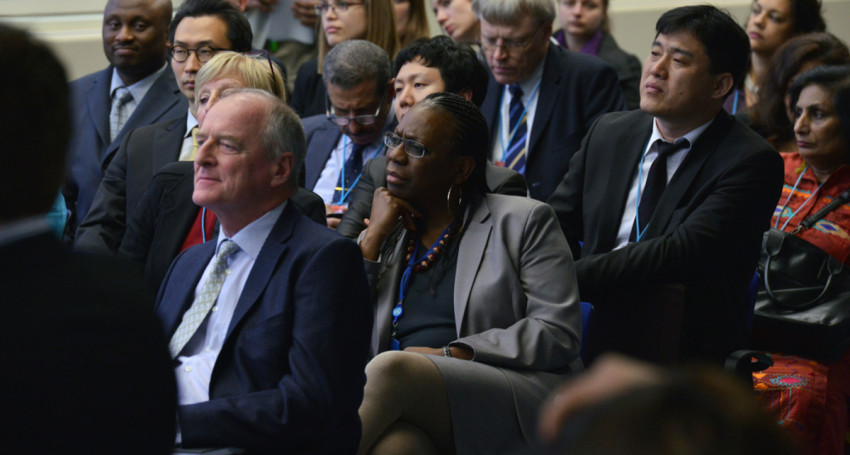
International Women's Day 2014. Photo courtesy of Flickr user IAEA Imagebank.
10 Do's and Don'ts of Gender Lens Investing
March 09, 2015
When Calvert Foundation launched our women's initiative, WIN-WIN, three years ago on International Women's Day, we approached it as a pilot initiative. Given that WIN-WIN was the only gender lens investment vehicle available to everyday investors (at that time), we wanted to test whether, and to what extent, investors would support the idea.
They responded well. In December 2013, we hit our goal of raising and lending $20 million to organizations that empower women, proving the demand for this type of opportunity and learning a lot along the way.
While we humbly recognize that that $20 million represents just 0.0001% of the reported wealth controlled by women, the upshot of WIN-WIN is that new gender lens investment strategies and products are becoming available. These are helping to prove that investing in women is smart and impactful.
Over the three blogs posts, I'll share some perspectives that I hope will continue this momentum, starting with the 10 do's and don'ts of gender lens investing.
1. DO put research into practice. The impact investing field has been the subject of many studies, as established think tanks seek to quantify the financial gaps and opportunities in certain markets, the impact benefits of certain products and services, and the needed resources to advance our field. We have relied heavily on these studies to inform our investment initiatives.
2. DON'T consider gender a sector. With the potential to lift households, communities and even countries out of poverty, investing in women is a global imperative. But women are not a sector. Rather, we should see women, or gender, as a lens because gender cuts across sectors. In each sector – access to finance, energy, health, education – we need to focus on certain gender elements that create more opportunity for women.
3. DO focus on one sector and its intersection with gender dynamics. We've learned that focusing on one particular sector offers the most potential to instill a gender mentality among both investors and investees. This gives them (and us) space to truly understand the gender dynamics of that sector. At the moment we are working at the intersection of women and energy. We also hope to incorporate gender into our global health and access to finance portfolios.
4. DON'T create super specific impact screens. Impact criteria should be aspirational and dynamic. For example, energy is a male dominated sector, yet the benefits to women are huge. If we only screen in organizations whose client base is majority women, then we miss the opportunity to inform these enterprises on how to take a more gendered approach within their operations, and as a result expand the impact to women.
5. DO collect data that has both an impact and financial benefit to the enterprise. Facing human capital constraints, many social enterprises consider impact reporting as an added investor requirement with no financial return. This perception could be reversed if we collect data that fit investors' impact reporting requirements, but also the enterprise's growth goals. For example, a solar energy distributor that collects gender data on their micro-distributors might begin to see a correlation between female distributors and increases in sales. They could then feed those insights back into their model, creating a continually evolving feedback loop.
6. DON'T over burden the end-borrower with exhaustive impact metrics requirements. With WIN-WIN we saw a huge improvement in data integrity and reporting timeliness when we tiered our reporting requirements into "must-have data" and "nice-to-have data".
7. DO focus on the type of investing you do best. Multiple studies conclude that certain sectors are fragmented and in their infancy. As a result, many investors are opportunistically investing along the entire financial value chain (e.g. lending to specific projects, social enterprises, financial intermediaries, etc.). Investors could create better outcomes by building their strengths in a particular vertical in the value chain. This could help fill in the gaps and facilitate the flow of capital to end borrowers. Our lending through WIN-WIN will be concentrated on financial intermediaries in the clean energy space, enabling these enterprises to scale and channel more capital to social enterprises.
8. DO partner with other investors to advance enterprises along the financial value chain. Enterprises needed different types of capital at different stages of their growth (e.g. seed financing, working capital, growth capital, etc.), but the reality is that certain types of capital are more available than other. As a result, many enterprises face the challenge of finding the appropriate type of capital. By encouraging investor partnerships, we can develop a more robust financing ecosystem for enterprises as they scale.
9. DON'T focus the gender analysis only on the impact side. The core of gender lens investing is to incorporate gender analysis in financial analysis to make better decisions. Criterion Institute, a leader in gender lens investing, will be launching a guide to help investors incorporate gender criteria into their due diligence.
10. DO share your successes, failures, and the lessons you've learned. As the glow from International Women's Day begins to dim over the next few weeks, how do we continue the momentum behind gender lens investing movement? Two key words come to mind: collaboration and communication. Collaboration with like-minded peers and dissimilar partners to create systems level change, and communication so build on each other's success and failures. Read more about collaboration in impact investing.
What have you learned about gender lens investing? Tell us in the comments below.




